高级微观经济学博弈论讲义复旦大学CCESYongqinWang1
复旦大学经济博弈论课件--经济博弈论242页PPT
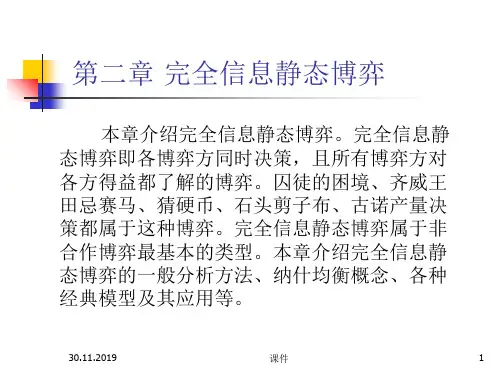
30.11.2019
课件
3
2.1.1 上策均衡
上策:不管其它博弈方选择什么策略,一博弈方 的某个策略给他带来的得益始终高于其它的策 略,至少不低于其他策略的策略
囚徒的困境中的“坦白”;双寡头削价中“低 价”。
上策均衡:一个博弈的某个策略组合中的所有策 略都是各个博弈方各自的上策,必然是该博弈 比较稳定的结果
课件
17
竞争:个体利益最大化
q1R 1(q2,q3)4 81 2q21 2q3
11 q2R 2(q 1,q3)4 82q 12q3 q 3R 3(q 1,q2)4 81 2q 11 2q2
q1 *q2 *q3 *24 u1*u2 *u3 *576
Q*72
u*1728
21
二、混合策略、混合策略博弈 和混合策略纳什均衡
混合策略:在博弈G {S1, Sn;u1, un中},博弈方 i的策略
空间为 Si {si1, sik},则博弈方 i以概率分布 pi (pi1, pik)
随机在其 k个可选策略中选择的“策略”,称为一个“混合策
略”,0其p中ij 1 j1, 对,k
u 1 u 1 ( P 1 ,P 2 ) P 1 q 1 c 1 q 1 ( P 1 c 1 ) q 1 (P 1 c 1 )a 1 ( b 1 P 1 d 1 P 2 )
u 2 u 2 ( P 1 ,P 2 ) P 2 q 2 c 2 q 2 ( P 2 c 2 ) q 2 (P 2 c 2 )a 2 ( b 2 P 2 d 2 P 1 )
上策均衡不是普遍存在的
30.11.2019
课件
4
2.1.2 严格下策反复消去法
严格下策:不管其它博弈方的策略如何变化, 给一个博弈方带来的收益总是比另一种策略 给他带来的收益小的策略
博弈论讲义lecture1
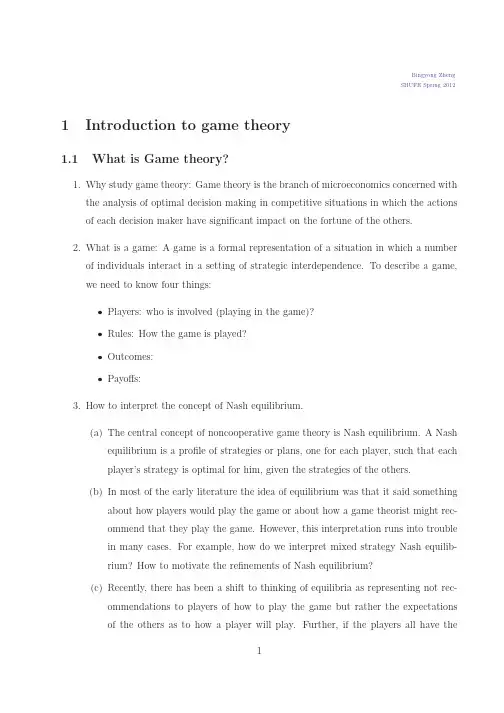
Bingyong ZhengSHUFE Spring2012 1Introduction to game theory1.1What is Game theory?1.Why study game theory:Game theory is the branch of microeconomics concerned withthe analysis of optimal decision making in competitive situations in which the actions of each decision maker have significant impact on the fortune of the others.2.What is a game:A game is a formal representation of a situation in which a numberof individuals interact in a setting of strategic interdependence.To describe a game, we need to know four things:•Players:who is involved(playing in the game)?•Rules:How the game is played?•Outcomes:•Payoffs:3.How to interpret the concept of Nash equilibrium.(a)The central concept of noncooperative game theory is Nash equilibrium.A Nashequilibrium is a profile of strategies or plans,one for each player,such that eachplayer’s strategy is optimal for him,given the strategies of the others.(b)In most of the early literature the idea of equilibrium was that it said somethingabout how players would play the game or about how a game theorist might rec-ommend that they play the game.However,this interpretation runs into troublein many cases.For example,how do we interpret mixed strategy Nash equilib-rium?How to motivate the refinements of Nash equilibrium?(c)Recently,there has been a shift to thinking of equilibria as representing not rec-ommendations to players of how to play the game but rather the expectationsof the others as to how a player will play.Further,if the players all have thesame expectations about the play of the other players we could as well think ofan outside observer having the same information about the players as they haveabout each other.1.2Rationality and common knowledege1.Rationality Assumption:mon knowledge:A standard assumption is that the game(players,strategies,andpayofffunctions)is common knowledge among mon knowledge is an important concept in game theory.A fact is common knowledge among players if each player knows the fact,and each player knows everyone else knows,and each knows everyone else knows everyone else knows,and so on.For example,a handshake is common knowledge between the two persons involved.When I shake hand with you,I know you know I know you know,.....,that we shake hand.Neither person can convince the other that she does not know that they shake hand.So,perhaps it is not entirely random that we sometimes use a handshake to signal an agreement or a deal.3.What if we don’t have common knowledge?Example1:Muddy children puzzlen children playing together.Each child wants to keep clean,but each would love to see the others get dirty.Now it happens during their play that some of the children, say k(k>1)of them,get mud on their foreheads.Each can see the mud on others but no on his own forehead.No one says a thing.Along comes the father,who says,“At least one of you has mud on your forehead.”The father then asks the following question,over and over:“Does any of you know whether you have mud on your own forehead?”Assuming that all the children are perceptive,intelligent,truthful,and that they answer simultaneously,what will happen?Example2:The general’s problemTwo divisions of an army,each commanded by a general,camped on two hilltops overlooking a valley the enemy stays.If both divisions attack the enemy simultaneously they will win the battle,while if only one division attacks it will be defeated.Neithergeneral will attack unless he is absolutely sure that the other will attack with him:a general will not attack if he receives no messages.The general of thefirst divisionwishes to coordinate a simultaneously attack(at some time the next day).They can communicate only by means of messengers.Normally,it takes a messenger one hour to get from on encampment to the other and on this particular night,everything goes smoothly.How long will it takes them to coordinate an attack?2Strategic form game2.1An subjective expected-utility maximization approach1.Definition:A strategic form game is a tuple G=(S i,u i)n i=1,where for all i,S i is theset of strategies available to player i,and u i:×n j=1S j→R is i’s payoffas a function of strategies chosen by all players.2.An subjective expected-utility approach interpretation(a)Each player has a subjective probability distribution over all states of the world–more precisely,the probabilities that her opponents playing s−i for all s−i∈×j=i S j.(b)Each player acts as an expected utility maximizer,choosing a strategy that max-imizes her expected payoffin the game given the probability distribution over thestrategies of her opponents.This is common knowledge.(c)The concept of Nash equilibrium imposes a further restriction,player’s belief isconsistent with the actual play of her opponents.3.The above interpretation of subjective expected utility-maximization provides a deci-sion theoretical foundation to the traditional definition of Nash equilibrium that each player plays optimally given the other players’equilibrium strategies.4.An important feature of the subjective expected utility approach is that it does notrequire randomization on the part of the players.Recall that the traditional interpre-tation of mixed strategies that assumes players explicitly randomize.The probabilisticnature of strategies now reflects the uncertainty of other players about a player’s choice.Thinking about the traditional Chinese“Scissor-rock-cloth”game.2.2Prisoner’s dilemma gameThe capacity expansion game between Honda and ToyotaToyotaBuild Do not buildHonda Build16,1620,15Do not build15,2018,181.Players:Toyota,Honda.2.Rules:Twofirms simultaneously choose to expand or not.Strategies for eachfirm:Build,Do not build.3.4outcomes:(Build,Build),(Build,Do not build),(Do not build,Build),(Do notbuild,Do not build).4.Payoffs:5.Nash equilibrium of this game:(Build,Build).2.3Strategies1.Definition:A strategy s i specifies the actions that a player will take under any con-ceivable circumstances that the player might face.2.A strategy is a complete contingency plan that says what a player will do at each ofher information sets if she is called on to play there3.A player’s strategy may include plans for actions that her own strategy makes irrele-vant.4.One interpretation for the specification of choices at information sets that won’t bereached given his strategy is that they are beliefs of his opponents about what he would do in case he does not follow his strategy,i.e.,the informations were reached.The belief of his opponents is important as their choices at those information sets are based on this belief.Furthermore,what the player’s opponents would do at those information sets rationalize his choice at at an upstream information set.Hence,this definition of strategy is not so odd when you interpret it as the way a player determines his strategy.5.Pure strategy and mixed strategyA mixed strategyσi∈∆(S i)specifies probabilities to two or more pure strategies.For example,the traditional Chinese game,rock,scissor and cloth.player2scissor rock clothPlayer1scissor0,0-1,11,-1rock1,-10,0-1,1cloth-1,11,-10,0Example2.A game of“match the coin”:Both players,Tom and Jack,choose whether to place the coin Head up or Tail up.Jack wins if two“Head”or two“Tail”appear, and loses otherwise.JackHead TailTom Head-1,11,-1Tail1,-1-1,12.3.1Dominant strategy1.Dominant strategy:A strategy s i is dominant for player i if for all s−i∈S−i ands′i∈S i/s iu i(s i,s−i)>u i(s′i,s−i).A strategy is a dominant strategy for a player if it is better than other strategies,nomatter what the others will choose.In any Nash equilibrium,players who have a dominant strategy play the dominant strategy.Thus,it is easy tofind the Nash equilibrium of games in which some of the players have a dominant strategy.2.“Confess”is a dominant strategy for prisoner1and prisoner2.Prisoner1Confess Not confessPrisoner2Confess-5,-50,-10Not confess-10,0-1,-13.Dominant strategies are rarity rather than norm.There is no dominant strategies inmost interesting games.2.3.2Dominated strategy1.A pure strategy s i∈S i is weakly dominated if there is another strategy s′i∈S i suchthat for all s−i∈S−i,u i(s′i,s−i)≥u i(s i,s−i),with strict inequality for some s−i.A strategy s i is strictly dominated for player i if there is another strategy s′i∈S i suchthat for all s−i∈S−iu i(s′i,s−i)>u i(s i,s−i).A strategy is strictly dominated when the player has another strategy that gives hera higher payoffno matter what the other player plays.2.Allowing mixed strategy:•A strategyσi is strictly dominated for player i if there is another strategyσ′i∈∆(S i)/σi such that for allσ−i∈∆(S−i)u i(σi,σ−i)<u i(σ′i,σ−i).•A pure strategy s i is strictly dominated for player i if and only if there existsσi∈∆(S i)such thatu i(s i,s−i)<u i(σi,s−i)for all s−i.3.A mixed strategy that assigns positive probability to a pure strategy that is strictlydominated is also strictly dominated.4.Modifies capacity expansion game between Toyota and HondaToyotalarge small not buildHonda large0,012,818,9small8,1216,1620,15not build9,1815,2018,18“large”is a dominated strategy for bothfirm as it can do better by choosing “small”,regardless of what the otherfirm is going to do.5.A player will not play a dominated strategy in Nash equilibrium.2.4Nash equilibrium2.4.1Definition and interpretation1.Definition:A strategy profile s∗=(s∗1,...,s∗n)is a Nash Equilibrium(NE)if for alli∈N and for all s′i∈S iU i s∗i,s∗−i ≥U i s′i,s∗−i .2.The central concept of noncooperative game theory is Nash equilibrium.A Nashequilibrium is a profile of strategies such that for each player in the game,given the strategy chosen by the other players,the strategy is a best response for the player, that is,the strategy gives the player the highest payoff.3.In early literature,the idea of equilibrium was that it said something about how playerswould play the game,or how game theorists would recommend them to play the game.More recently,game theorists look to an alternative interpretation.According to this interpretation,an equilibrium is taken as every player making optimal choice given the belief about how opponents would play the game given their respective beliefs.4.While thefirst interpretation of the equilibrium can be problematic in case of mixedstrategy equilibrium,the second interpretation can accommodate mixed strategies without any trouble.In this scenario,the mixed strategy of a player does not rep-resent a conscious randomization on the part of that player,but rather the uncertainty in the minds of the others as to how that player will act.Hence,the second inter-pretation of Nash equilibrium has become the preferred interpretation among game theorists.Thus the focus of the equilibrium analysis becomes,not the choices of the players, but the assessments of the players about the choices of the others.The basic consis-tency condition that we impose on the players’assessments is this:A player reasoning through the conclusions that others would draw from their assessments should not be led to revise his own assessment.2.4.2Find NE in two-player gamesIn games with dominant and dominated strategies1.Most games havefinite and ODD number of NE.Example:L M RT3,30,23,0B0,03,20,32.If both players have a dominant strategy,then playing dominant strategies is the uniqueNash equilibrium in the game.3.If one player has a dominant strategy,this strategy will be this player’s NE strat-egy.The other player’s NE strategy is the best response to her opponent’s dominant strategy.4.If players have dominated strategies,delete the dominated strategies from the gameand work with a smaller game.ExamplePlayer2A B CPlayer1A5,815,1010,5B10,1520,915,0C20,2010,1010,85.NE must be a mutual best-response,that,given player1plays NE strategy,player2can not do better by playing some other strategies,similarly,given player2plays this strategy,player1can not do better by changing strategies.A NE is a strategy profile in which both players are playing the best-response given the other player’s strategy.2.4.3Three player game1.A simple examplePlayer2U D Player1A(1,1,0)(2,-2,5)B(1,-2,-1)(0,3,1)Player2U D Player1A(1,1,-2)(2,-2,5)B(2,2,-1)(2,3,7)Player3plays L Player3plays R Pure strategy NE in this game:(A,U,L),(B,D,R).2.Another examplePlayer2U V WL3,0,22,-1,01,-2,0 Player1M3,2,11,4,-10,0,-2R1,1,100,2,1-2,0,3Player2U V WL2,1,13,0,02,-2,-1 M5,4,21,3,43,0,-2 R1,1,10,2,0-2,0,2Player3plays A Player3plays BPlayer2U V WL2,1,-13,0,-12,-2,-3Player1M5,4,-11,3,-23,0,-4R1,1,-100,2,-1-2,0,-2Player3plays CPlayer1’s dominated strategy R,player2’s dominated strategy W.Player3’s domi-nated strategy C.The pure strategy NE in this game(L,U,A),(M,U,B).2.4.4Strategic Stability of NE1.Being a NE is a necessary condition for an obvious way to play the game,if an obviousway to play the game exists.But•Being NE is not sufficient for a strategy profile to be the obvious way to play agiven game.•Not every game admits an obvious way to play the game2.Some questions to be answered:•How can we refine NE,the necessary condition to get the prediction of the game,an obvious way to play the game.NE can involve weakly dominated strategies,we should add to our necessarycondition that the solution should be a NE in strategies that are undominated,even weakly•What are the means by which we are to identify“obvious way to play a game?”•What can one say about games that do not admit a“solution”When the game does not admit an“obvious way to play,”looking at its NE can give precisely the wrong answer.The concept of NE is of no use when the game admits no“solution”3.On occasion the requirement of Nash equilibrium can be too demanding at times.This leads to two less restrictive concepts:rationalizability,and correlated equilibrium.Some new solution concepts are thus advanced:rationalizability,correlated equilibrium4.Rationalizability(Pearce1984Econometrica)•Rationalizable strategies:•A strategyσi is a best response for player i to her rivals’strategiesσ−i ifu i(σi,σ−i)≥u i(σ′i,σ−i).for allσ′i∈∆(S i)•Strategyσi is never a best response if there is noσ−i for whichσi is a best response.•The strategies in∆(S i)that survive iterated deletion removal of strategies that are never a best response are known as player i’s rationalizable strategies.Player2b1b2b3b4a10,72,57,00,1Player1a25,23,35,20,1a37,02,50,70,1a40,00,-20,010,-15.At other times,the requirement of NE is not strong enough to rule out multiple equi-libria or implausible predictions.Two lines of research to address these difficulties:•Equilibrium selection:concerned with narrowing the prediction to a single pre-diction.See A General Theory of Equilibrium Selection in Games/Harsany and Selten,1988.•Refinement of NE:concerned with establishing necessary conditions for reasonablepredictions.2.5Iterated Deletion of Strictly Dominated Strategies1.Now in situations where players do not have a chance to talk or where there is nohistory to rely on,Nash equilibrium may not be a good prediction.So in this case,we may prefer a solution concept that does not make strong assumptions about players knowing what each other is going to do.2.A rational player should never choose a strictly dominated strategies because thereexists another strategies that is strictly better.Note that if a player has a dominant strategies,then all other strategies are dominated.3.Consider the following game(Gibbons pp.6):Player2Player1L M R U1,01,20,1 D0,30,12,04.Note that R is strictly dominated by M for Player2.Now,if Player1knows thatPlayer2is rational,then Player1knows that Player2will never choose R.If R is eliminated,then D becomes dominated by U.Now,if Player2knows Player1knows that Player2is rational,then Player2knows that Player1will not choose D.In that case,Player2should choose M.5.If it is common knowledge that both players are rational,we can continue this processindefinitely.6.Note that Nash and IDSDS are based on different logic.IDSDS does not require thatthe players know that the equilibrium is going to be played,so it requires less coordi-nation.However,common knowledge of rationality is itself a very strong assumption.7.For two-player games,rationalizable strategies are those remaining after the iterativedeletion of strictly dominated strategies.8.For more than two player games,this is no longer true.See,for example.L R U90 D00L RU09D90L RU00D09L RU60D06A B C DIn this example,D is not dominated,but never a best response for player3.2.6Existence of NE1.Theorem1(Theorem7.2,Jehle and Reny).Everyfinite strategic form game has atleast one NE.Proof.See Jehle and Reny pp.278.2.Theorem2.NE exists if the strategy set of each player is a compact and convex subsetof an Euclidean space and if the utility function of each player is continuous in the strategy profile and quasi-concave in one’s own strategy.Proof.Step1:the maximizerb i(σ−i)=arg maxσi∈∆(S i)u i(σi,σ−i)is nonempty,convex-valued and upper hemicontinuous.Step2:by Kukutani’sfixed point theorem,a non-empty,convex-valued upper hemi-continuous correspondence b i(σ−i)mapping from∆(S)to itself,there must exists a fixed point.3Normal-form perfect equilibrium1.The problem with NE is,that,many games have multiple equilibria.The naturalquestion then arises,can we go any further and rule out any equilibria as self-enforcing assessment of the game.Indeed,on occastion irrational assessments by two different players might each make the other look rational.2.As an example,consider the following gameb1b2a13,30,0a2-5,-50,-5But is(a2,b2)a good prediction of the game?Not likely.3.Anǫ-perfect equilibrium of the normal form game is a totally mixed strategyσ≡(σ1,...,σN),if for all i and for all s i,s′i∈S i,u i(s i,σ)>u i(s′i,σ)thenσi(s′i)≤ǫ.4.A perfect equilibrium of a normal form game is a limit(ǫ→0)ofǫ-perfect equilibria.5.For two-player game,any NE in which no player plays dominated strategies is perfect.6.For more than two-player game,the above statement is not true.There are NE withno players playing dominated strategies that is not perfect.Player2L R Player1T(1,1,1)(1,0,1)B(1,1,1)(0,0,1)Player2L R Player1T(1,1,0)(0,0,0)B(0,1,0)(1,0,0)Player3plays l Player3plays r•(B,L,l)is a NE with no weakly dominated strategies.•However,for any small probabilities player2assigns to R and player3to r,the expected payofffor player1from T is greater than that from B.Thus,there exists noǫ-perfect equilibrium in which the totally mixed strategy profile assigns more thanǫto B.7.Perfect equilibrium does not eliminate all unreasonable outcomes in some games.Adding a domianted strategy may enlarge the set of perfect equilibria.Consider the following example.L2M2 L11,10,0 M10,00,0L2M2R2 L11,10,0-1,-2 M10,00,00,-2 R1-2,-1-2,0-2,-2。
【复旦大学微观经济学课件】微观经济学-第七章-文档资料

© copyrights by Jianliang Feng 2006. Fudan University.
垄断形成的原因
• 垄断形成与存在的原因 1) 独家厂商控制了生产某种商品的全部资源或基 本资源的供给 2) 独家厂商拥有生产某种商品的专利权 3) 政府的特许 4) 显著的规模经济,如自来水公司、煤气公司, 即自然垄断
© copyrights by Jianliang Feng 2006. Fudan University.
垄断厂商的收益曲线与需求弹性
• 总收益、边际收益与需求弹性的关系
M R d T R d ( P Q ) P Q d P P ( 1 d P Q ) P ( 1 1 ) d Qd Q d Q d Q P e d
11
© copyrights by Jianliang Feng 2006. Fudan University.
主题内容
• 第一节 垄断市场的涵义与特征 第二节 垄断企业的行为与经济效率 • 第三节 垄断厂商的价格歧视 • 问/答
12
© copyrights by Jianliang Feng 2006. Fudan University.
• 两种盈亏分析法(续) TC
$
E0
B
A
E
TR
总收益—总成本分析法
O
Q1
$
P0Biblioteka OQ1Q3 Q2
Q
MC AC
边际收益—边际成本分析法
MR
Q3 Q2
D=AR
Q
14
© copyrights by Jianliang Feng 2006. Fudan University.
垄断厂商的短期均衡
复旦大学微观经济学教师手册*12 博弈论
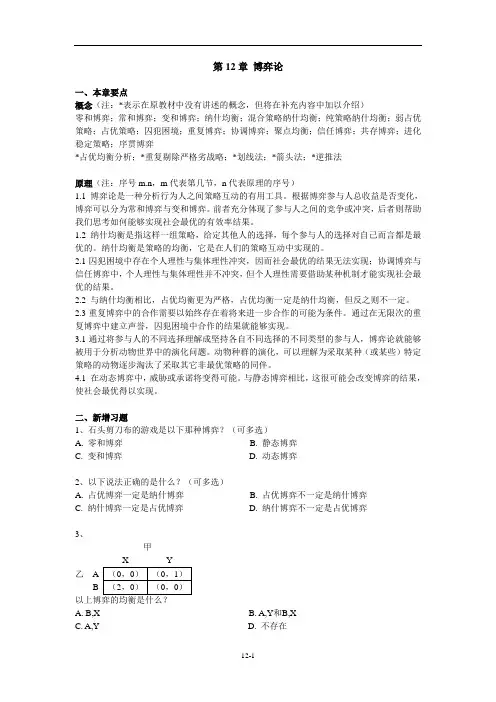
第12章博弈论一、本章要点概念(注:*表示在原教材中没有讲述的概念,但将在补充内容中加以介绍)零和博弈;常和博弈;变和博弈;纳什均衡;混合策略纳什均衡;纯策略纳什均衡;弱占优策略;占优策略;囚犯困境;重复博弈;协调博弈;聚点均衡;信任博弈;共存博弈;进化稳定策略;序贯博弈*占优均衡分析;*重复剔除严格劣战略;*划线法;*箭头法;*逆推法原理(注:序号m.n,m代表第几节,n代表原理的序号)1.1 博弈论是一种分析行为人之间策略互动的有用工具。
根据博弈参与人总收益是否变化,博弈可以分为常和博弈与变和博弈。
前者充分体现了参与人之间的竞争或冲突,后者则帮助我们思考如何能够实现社会最优的有效率结果。
1.2 纳什均衡是指这样一组策略,给定其他人的选择,每个参与人的选择对自己而言都是最优的。
纳什均衡是策略的均衡,它是在人们的策略互动中实现的。
2.1囚犯困境中存在个人理性与集体理性冲突,因而社会最优的结果无法实现;协调博弈与信任博弈中,个人理性与集体理性并不冲突,但个人理性需要借助某种机制才能实现社会最优的结果。
2.2 与纳什均衡相比,占优均衡更为严格,占优均衡一定是纳什均衡,但反之则不一定。
2.3重复博弈中的合作需要以始终存在着将来进一步合作的可能为条件。
通过在无限次的重复博弈中建立声誉,囚犯困境中合作的结果就能够实现。
3.1通过将参与人的不同选择理解成坚持各自不同选择的不同类型的参与人,博弈论就能够被用于分析动物世界中的演化问题。
动物种群的演化,可以理解为采取某种(或某些)特定策略的动物逐步淘汰了采取其它非最优策略的同伴。
4.1 在动态博弈中,威胁或承诺将变得可能。
与静态博弈相比,这很可能会改变博弈的结果,使社会最优得以实现。
二、新增习题1、石头剪刀布的游戏是以下那种博弈?(可多选)A. 零和博弈B. 静态博弈C. 变和博弈D. 动态博弈2、以下说法正确的是什么?(可多选)A. 占优博弈一定是纳什博弈B. 占优博弈不一定是纳什博弈C. 纳什博弈一定是占优博弈D. 纳什博弈不一定是占优博弈3、甲乙 AB以上博弈的均衡是什么?A. B,XB. A,Y和B,XC. A,YD. 不存在4、两家公司甲和乙都希望发展一项新技术,考虑市场风险,技术的兼容性很重要。
高级微观经济学 第八章 博弈论
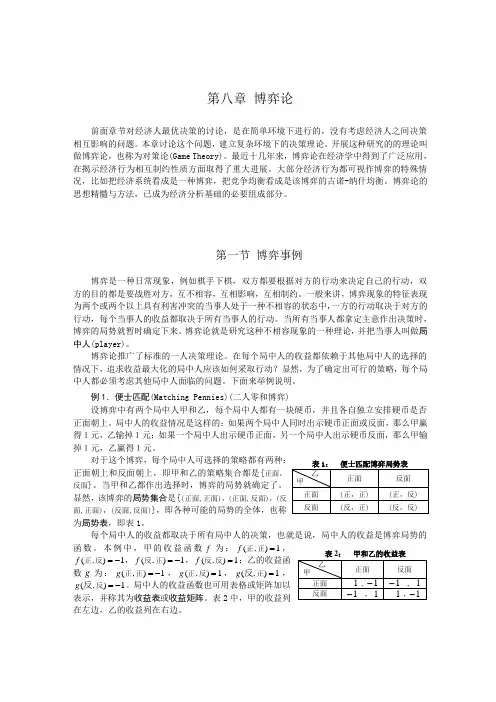
第八章 博弈论前面章节对经济人最优决策的讨论,是在简单环境下进行的,没有考虑经济人之间决策相互影响的问题。
本章讨论这个问题,建立复杂环境下的决策理论。
开展这种研究的的理论叫做博弈论,也称为对策论(Game Theory)。
最近十几年来,博弈论在经济学中得到了广泛应用,在揭示经济行为相互制约性质方面取得了重大进展。
大部分经济行为都可视作博弈的特殊情况,比如把经济系统看成是一种博弈,把竞争均衡看成是该博弈的古诺-纳什均衡。
博弈论的思想精髓与方法,已成为经济分析基础的必要组成部分。
第一节 博弈事例博弈是一种日常现象,例如棋手下棋,双方都要根据对方的行动来决定自己的行动,双方的目的都是要战胜对方,互不相容,互相影响,互相制约。
一般来讲,博弈现象的特征表现为两个或两个以上具有利害冲突的当事人处于一种不相容的状态中,一方的行动取决于对方的行动,每个当事人的收益都取决于所有当事人的行动。
当所有当事人都拿定主意作出决策时,博弈的局势就暂时确定下来。
博弈论就是研究这种不相容现象的一种理论,并把当事人叫做局中人(player)。
博弈论推广了标准的一人决策理论。
在每个局中人的收益都依赖于其他局中人的选择的情况下,追求收益最大化的局中人应该如何采取行动?显然,为了确定出可行的策略,每个局中人都必须考虑其他局中人面临的问题。
下面来举例说明。
例1.便士匹配(Matching Pennies)(二人零和博弈)设博弈中有两个局中人甲和乙,每个局中人都有一块硬币,并且各自独立安排硬币是否正面朝上。
局中人的收益情况是这样的:如果两个局中人同时出示硬币正面或反面,那么甲赢得1元,乙输掉1元;如果一个局中人出示硬币正面,另一个局中人出示硬币反面,那么甲输掉1元,乙赢得1元。
对于这个博弈,每个局中人可选择的策略都有两种:正面朝上和反面朝上,即甲和乙的策略集合都是{正面,反面}。
当甲和乙都作出选择时,博弈的局势就确定了。
显然,该博弈的局势集合是{(正面,正面),(正面,反面),(反面,正面),(反面,反面)},即各种可能的局势的全体,也称为局势表,即表1。
复旦大学 高级微观经济学课件1
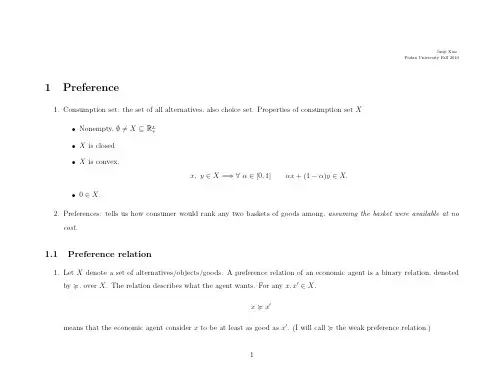
complete. Since the ordering on real number is transitive, the preference relation must be transitive. 4. To ensure that a preference relation over a convex subset of RL is representable by a utility function, we need an extra axiom: 5. It is straightforward to see that the lexicographic preference relation is complete and transitive. But this relation cannot be represented by a utility function. Suppose we let u (x) = x1 . While, this utility function yields the right relation between all x and x when x1 = x1 , it does not when x1 = x1 . However, we have already used up all the real numbers—every real number will be the utility of some consumption bundles. There is nothing left to capture the effect of x2 . 6. Theorem. A preference relation that is complete, transitive, continuous, and defined over a convex subset of RL , can be
博弈论讲义
1.4.2博弈论的形成
冯.诺伊曼和摩根斯坦《博弈论和经济行为》 Theory of Games and Economic Behavior 1944 引进扩展形(extensive form)表示和正规形 (normal form)或称策略形(strategy form)、 矩阵形(matrix form)表示 提出稳定集(stable sets)解概念 正式提出创造博弈论一般理论的主意 给出博弈论研究的一般框架、概念术语和表述 方法
一、基本模型
囚徒 2 坦 白 囚 坦 白 徒 1 不坦白 囚徒1:坦白 囚徒2:坦白 -5, -5 -8, 0 不坦白 0, -8 -1, -1
两个罪犯的得益矩阵
二、双寡头削价竞争
寡头2 高 价 寡 头 1 高 价 低 价 100,100 150,20 低 价 20,105 70,70
双寡头的得益矩阵
1.3.3 博弈中的得益
得益:各博弈方从博弈中所获得的利益 得益对应博弈的结果,也就是各博弈方策 略的组合 得益是各博弈方追求的根本目标及行为和 判断的主要依据 根据得益的博弈分类:零和博弈、常和博 弈、变和博弈
零和博弈:也称“严格竞争博弈”。博弈方之 间利益始终对立,偏好通常不同 —猜硬币,田忌赛马,石头-剪刀-布 常和博弈:博弈方之间利益的总和为常数。博 弈方之间的利益是对立的且是竞争关系 —分配固定数额的奖金、利润,遗产官司 变和博弈:零和博弈和常和博弈以外的所有博 弈。合作利益存在,博弈效率问题的重要性。 —囚徒困境、产量博弈、制式问题等
1.1.2 一个非技术性定义
定义:博弈就是一些个人、队组或其他组织,面对一定 的环境条件,在一定的规则下,同时或先后,一次或多 次,从各自允许选择的行为或策略中进行选择并加以实 施,各自取得相应结果的过程。
复旦大学经济博弈论课件--经济博弈论4-文档资料
2019/2/28
课件
16
4.3.2唯一纯策略纳什均衡博弈 的无限次重复博弈
2019/2/28 课件 5
重复博弈的得益
平均得益 :如果一常数 作为重复博弈(有限次 重复博弈
无限次重复博弈)各个 阶段的得益,能产生与 得益序列
, 相同的现在值,则称 为 , 的平均得益 1 , 2 1 , 2
有限次重复博弈不一定 考虑贴现因素
t 1 无限次重复博弈必须考 虑贴现问题 ( 1 ) t t 1
2019/2/28
课件
6
4.2 有限次重复博弈
4.2.1 两人零和博弈的有限次重复博弈 4.2.2唯一纯策略纳什均衡博弈 的有限次重复博弈 4.2.3多个纯策略纳什均衡博弈 的有限次重复博弈 4.2.4 有限次重复博弈的民间定理
2019/2/28 课件 7
4.2.1 两人零和博弈的有限次重复博弈
低 价
20,150 70,70
有唯一纯策略纳什均衡 (70,70) 有限次重复的结果仍然是 (低价,低价)
削价竞争博弈
2019/2/28
课件
10
4.2.3多个纯策略纳什均衡博弈的 有限次重复博弈
厂商2
厂 商 1
H M L
H 5,5 6,0 2,0
M 0,6 3,3 2,0 三价博弈
L 0,2 0,2 1,1
厂 H 商 M 1 L
H 8,8 7,1 3,1
厂商2 M 1,7 4,4 3,1
L 1,3 1,3 2,2
两次重复三价博弈的等价模型
触发策略:两博弈方先试探合作,一旦发现对方不合作则也用不合作报复 博弈方1:第一次选h;如第一次结果为(H,H),则第二次选M,否则选L 博弈方2:同博弈方1
复旦大学 高级微观经济学课件7
lottery is evaluated according to the expected value of u.
1.2 Axioms on preferences over gambles
1. Completeness. 2. Transitivity. 3. Given Axioms 1 and 2, we can rank all outcomes in A. (ai can be viewed as a degenerate gamble that yields outcome 1 with probability one.) Without loss of generality, we assume a1 a2... an.
jectively defined. 3. A compound gamble is a gamble whose prizes are gambles (simple or compound). For any compound gambles, we can calculate the probability of each outcome. (I use the term “prize” to refer to what one may receive from a gamble. A prize may be another gamble or an outcome in A.) 4. Example: suppose A = {+1, −1}. g1 = (p1 ◦ 1, (1 − p1) ◦ −1) g2 = (p2 ◦ 1, (1 − p2) ◦ −1) g3 = (q ◦ g1, (1 − q ) ◦ g2)
9
to x is also better than x . 5. The Independence Axiom. For any gambles g , g , g , and α ∈ (0, 1), g g ⇔ αg + (1 − α) g αg + (1 − α) g .
复旦大学微观经济学讲义-by经济学院中国经济研究中心冯曲老师
与无约束相比, dx1 , dx 2 的大小不是任意的,而是相互联系的,即确定了 dx1 , 则 dx 2 也就相应确定了(一般的,相互联系的机制有约束条件决定) 。在这个例 子中, dx 2 和 dx1 的比例就等于预算线的斜率,作为平行四边形对角线的 dx 的方 向也就确定了,就是沿预算线移动。 梯度向量 f x 的几何意义是:等值面 f ( x) = k 在点 x 处指向值增加(变化) 的法方向,也就是在点 x 处 f(x)值增加最快的方向,其变化率为 f x 的模。如上
< α ≤ π ,则 x ⋅ y < 0
现在分析梯度向量 f x 和 dx 的几何意义:
dx 代表欧氏空间中一点 x 微小变化的向量,方向变化的大小。具体的,如下图,以二维为例, dx = (dx1 , dx 2 ) 的分 量分别表示从点 x 出发横轴和纵轴变化的方向,向量 dx 则表示从点 x 变化的整 体方向,具体的,满足平行四边形法则。
同时,也可以表示成: x ⋅ y = x y cos α ,或 cos α =
x⋅ y ,其中 α 表示向 x y
量 x,y 之间的夹角, x , y 分别表示向量 x,y 的模(原点到点 x、y 的距离) 。 如果
0≤α <
π
2
,则 x ⋅ y > 0 ;
α= π
2
π
2
,则 x ⋅ y = 0 ,即向量 x,y 正交(垂直) ;
复旦大学微观经济学讲义
—— 经济学院中国经济研究中心冯曲老师
本资料源自公开出版物或相关院校内部 由复清发展金融考研咨询社编辑整理
A Brief Lecture Notes on Optimization for Microeconomic Analysis1
- 1、下载文档前请自行甄别文档内容的完整性,平台不提供额外的编辑、内容补充、找答案等附加服务。
- 2、"仅部分预览"的文档,不可在线预览部分如存在完整性等问题,可反馈申请退款(可完整预览的文档不适用该条件!)。
- 3、如文档侵犯您的权益,请联系客服反馈,我们会尽快为您处理(人工客服工作时间:9:00-18:30)。
Payoffs received by each player for the combinations of the strategies, or for each player, preferences over the combinations of the strategies
Static Games of Complete Information-Lecture 1
Nash Equilibrium-Pure Strategy
Yongqin Wang, yongqinwang@ CCES, Fudan University
Outline of Static Games of Complete Information
Two players must simultaneously choose whether to show the Head or the Tail.
Both players know the following rules:
➢ If two pennies match (both heads or both tails) then player 2 wins player 1’s penny.
Prisoner 2
Mum
Confess
-1 , -1 -9 , 0
0 , -9 -6 , -6
Dec, 2006, Fudan University
Game Theory--Lecture 1
6
Example: The battle of the sexes
At the separate workplaces, Chris and Pat must choose to attend either an opera or a prize fight in the evening.
8
Static (or simultaneous-move) games of complete information
A static (or simultaneous-move) game consists of:
A set of players (at least two players)
Game theory has applications
➢ Economics ➢ Politics ➢ Sociology ➢ Law ➢ etc.
Dec, 2006, Fudan University
Game Theory--Lecture 1
5
Classic Example: Prisoners’ Dilemma
Both Chris and Pat know the following:
➢Both would like to spend the evening together.
➢But Chris prefers the opera.
➢Pat prefers the prize fight. Pat Opera Prize Fight
Opera Chris
Prize Fight
2, 1 0, 0
0, 0 1, 2
Dec, 2006, Fudan University
Game Theory--Lecture 1
7
Example: Matching pennies
Each of the two players has a penny.
➢ {Player 1, Player 2, ... Player n}
➢ S1 S2 ... Sn
➢ ui(s1, s2, ...sn), for all s1S1, s2S2, ... snSn.
Dec, 2006, Fudan University
Game Theory--Lecture 1
9
Dec, 2006, Fudan University
Game Theory--Lecture 1
10
Static (or simultaneous-move) games of complete information
The players cooperate? ➢ No. Only non-cooperative games ➢ Methodological individualism
Dec, 2006, Fudan University
Game Theory--Lecture 1
12
Dec, 2006, Fudan University
Game Theory--Lecture 1
13
Classic example: Prisoners’ Dilemma: normal-form representation
players; there is strategic interaction
Example: Six people go to a restaurant.
➢ Each person pays his/her own meal – a simple decision problem
➢ Before the meal, every person agrees to split the bill evenly among them – a game
Players Strategies
Prisoner 1
Mum Confess
Prisoner 2
Mum
Confess
-1 , -1 -9 , 0
0 , -9 -6 , -6
Payoffs
Dec, 2006, Fudan University
Game Theory--Lecture 1
➢ If neither confesses then both will be convicted of a minor offense and sentenced to one month in jail.
➢ If both confess then both will be sentenced to jail for six months.
The timing ➢ Each player i chooses his/her strategy si without knowledge of others’ choices. ➢ Then each player i receives his/her payoff ui(s1, s2, ..., sn). ➢ The game ends.
Dec, 2006, Fudan University
Game Theoryt is game theory?
Game theory is a formal way to analyze strategic interaction among a group of rational players (or agents)
Two suspects held in separate cells are charged with a major crime. However, there is not enough evidence.
Both suspects are told the following policy:
Dec, 2006, Fudan University
Game Theory--Lecture 1
11
Definition: normal-form or strategicform representation
The normal-form (or strategic-form) representation of a game G specifies:
Set of players:
{Prisoner 1, Prisoner 2}
Sets of strategies: Payoff functions:
S1 = S2 = {Mum, Confess}
u1(M, M)=-1, u1(M, C)=-9, u1(C, M)=0, u1(C, C)=-6; u2(M, M)=-1, u2(M, C)=0, u2(C, M)=-9, u2(C, C)=-6
Static (or simultaneous-move) games of complete information
Normal-form or strategic-form representation
Dec, 2006, Fudan University
Game Theory--Lecture 1
➢ Otherwise, player 1 wins player 2’s penny.
Player 1
Head Tail
Player 2
Head
Tail
-1 , 1 1 , -1
1 , -1 -1 , 1
Dec, 2006, Fudan University
Game Theory--Lecture 1
3
What is game theory?
We focus on games where:
➢ There are at least two rational players ➢ Each player has more than one choices ➢ The outcome depends on the strategies chosen by all
Static (or simultaneous-move) games of complete information
Simultaneous-move ➢ Each player chooses his/her strategy without knowledge of others’ choices.
